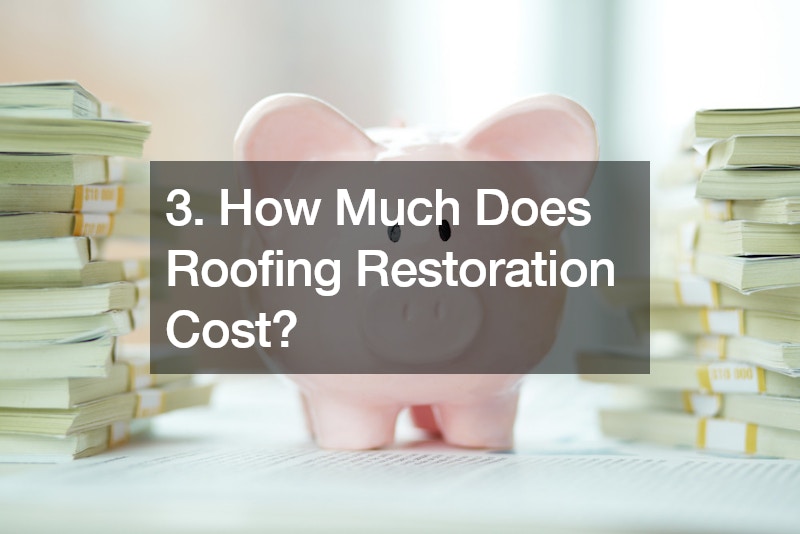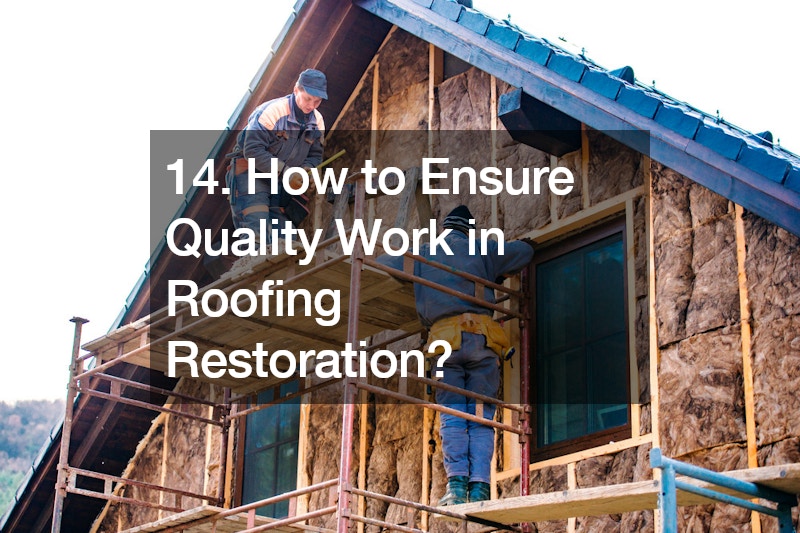1. What is a Roofing Restoration?
A roofing restoration is the process of repairing and rejuvenating a roof that has deteriorated over time due to weathering, age, or neglect. This involves addressing any damage, applying protective coatings, and ensuring the structural integrity of the roof.
One of the key benefits of roofing restorations is that they can extend the lifespan of a roof significantly, saving homeowners the cost and hassle of a full roof replacement. Additionally, restorations can improve energy-efficiency and enhance the overall appearance of a property.
It is essential to consider roofing restorations as a proactive maintenance measure to prevent more extensive damage and costly repairs in the future. A well-maintained roof can also increase the value of a home and provide peace of mind to homeowners.
2. When is Roofing Restoration Needed?
There are several signs that indicate the need for roofing restoration, including leaks, water damage, mold growth, missing shingles, and sagging areas on the roof. It is crucial to address these issues promptly to prevent further damage to the roof and the interior of the home.
Timely roofing restoration is essential to avoid more extensive and costly repairs in the future. Neglecting necessary repairs can lead to structural damage, compromised safety, and higher energy bills due to poor insulation and ventilation.
Homeowners should schedule regular inspections with a local roofer or roofing expert to assess the condition of their roof and determine if restoration work is needed. Early detection of problems can save time and money in the long run.

3. How Much Does Roofing Restoration Cost?
The cost of roofing restoration can vary depending on several factors, including the size and complexity of the project, the materials used, and the extent of the damage. On average, roofing restorations can range from $5,000 to $15,000, but this cost can increase for larger or more intricate projects.
When comparing the cost of roofing restoration with a full roof replacement, restoration is typically more cost-effective. Restorations can address specific issues while preserving the existing roof structure, saving homeowners money in the long term.
It is recommended to obtain quotes from local roofing services and compare their estimates to find the best value for local roof repairs and restoration services. Homeowners should also consider the long-term benefits and savings of restoring their roof rather than replacing it entirely.
4. How Long Does Roofing Restoration Take?
The timeline for roofing restoration can vary depending on the scope of the project, weather conditions, and any unforeseen issues that may arise during the process. On average, a roofing restoration can take anywhere from a few days to a few weeks to complete.
Factors that can cause delays in roofing restoration include inclement weather, supply shortages, and the need for additional repairs that were not initially identified. Homeowners should work closely with their roofing contractor to establish a realistic timeline for the project.
To avoid delays during roofing restoration, it is essential to properly prepare the home, clear the work area of any obstacles, and communicate regularly with the contractor to address any concerns or changes to the project timeline.
5. Are Permits Required for Roofing Restoration?
Permit requirements for roofing restoration can vary depending on the location and the extent of the work being done. In general, minor repairs and maintenance may not require a permit, but more extensive restoration projects, such as roof replacements or structural changes, often do.
It is crucial for homeowners to understand the permit requirements for roofing restoration in their area and obtain the necessary permits before starting the project. Failure to obtain permits can result in fines, delays, or even the halt of work by local authorities.
A reputable roofing business will typically handle the permit application process on behalf of the homeowner, ensuring that all necessary approvals are obtained before beginning the restoration work. Homeowners should discuss permit requirements with their contractor before finalizing the project details.

6. What Materials are Used in Roofing Restoration?
Common roofing materials used in restoration projects include asphalt shingles, metal roof products, clay tiles, and slate. These materials are chosen based on factors such as durability, cost, aesthetic appeal, and environmental impact.
For homeowners interested in sustainable and energy-efficient options, there are eco-friendly roofing materials available, such as solar panels, cool roofs, and green roofs. These materials can help reduce energy consumption, lower utility bills, and minimize the environmental footprint of a property.
When planning a roofing restoration, homeowners should consult with their roofing contractor to explore the various material options available and select the best choice for their specific needs and budget. The right materials can enhance the longevity and performance of a restored roof.
7. Do I Need to Prepare My Home for Roofing Restoration?
Before roofing restoration begins, homeowners should prepare their home by removing any valuable items from the attic or upper floors, protecting furniture and belongings from dust and debris, and ensuring that pets and children are kept away from the work area.
During the restoration process, homeowners may need to make temporary accommodations, especially if the work involves extensive repairs or if the home’s interior is affected by the restoration work. It is important to communicate with the roofing contractor and plan accordingly for any disruptions to daily routines.
Proper preparation for roofing restoration can help streamline the project, minimize disruptions to the household, and ensure the safety of occupants during the construction process. Homeowners should follow the guidance of their residential roofers to create a smooth and efficient restoration experience.
8. Can Roofing Restoration Be Done DIY?
While some minor roofing repairs can be done DIY, such as replacing a few shingles or fixing minor leaks, roofing restoration projects are best left to professional residential roofing contractors. Restorations require specialized knowledge, skills, and equipment to ensure the job is done correctly and safely.
Attempting to complete roofing restoration work without the necessary expertise can result in costly mistakes, further damage to the roof, and safety hazards for the homeowner. Hiring a professional roofing contractor ensures that the restoration is completed to industry standards and meets local building codes.
Homeowners should prioritize safety and quality when considering roofing restoration and invest in the expertise of a reputable local roofer or roofing expert to achieve the best results. Professional contractors have the experience and resources to deliver high-quality restoration work that stands the test of time.

9. How to Choose a Roofing Restoration Contractor?
When selecting a roofing restoration contractor, homeowners should conduct thorough research, read reviews and testimonials, and request references from past clients to assess the contractor’s reputation and quality of work. It is essential to choose a contractor with proven experience in roofing restorations.
Homeowners should also ask potential contractors about their licensing, insurance coverage, warranties, and certifications to ensure they are qualified to perform the restoration work. Additionally, requesting detailed cost estimates and timelines can help homeowners make an informed decision when hiring a contractor.
By vetting multiple roofing contractors and comparing their credentials, workmanship, and costs, homeowners can select a reliable and skilled professional for their roofing restoration project. Building a strong partnership with a reputable contractor is key to a successful and stress-free restoration experience.
10. What Should I Expect During Roofing Restoration?
During roofing restoration, the contractor will typically conduct an initial inspection and assessment of the roof to identify any damage, leaks, or areas in need of repair. This assessment helps create a detailed restoration plan that addresses the specific needs of the roof.
Once the restoration plan is approved, the contractor will begin executing the necessary repairs, replacements, and upgrades to restore the roof to its original condition. Throughout the restoration process, homeowners can expect regular progress updates and clear communication from the contractor.
Upon completion of the restoration work, the contractor will conduct a final inspection to ensure that the roof meets industry standards and the homeowner’s expectations. Homeowners should inspect the completed work and address any concerns with the contractor before finalizing the project.
11. How to Maintain a Restored Roof?
After a roofing restoration is completed, it is essential for homeowners to schedule regular inspections and maintenance checks to keep the roof in optimal condition. Inspecting the roof for signs of damage, cleaning gutters, and trimming trees near the roof can help prevent issues that may require future repairs.
Additionally, homeowners should follow maintenance tips provided by their roofing contractor to extend the lifespan of the restored roof and ensure it remains in good condition for years to come. Timely repairs, proper ventilation, and cleaning can help avoid costly damage and prolong the life of the roof.
By investing in regular maintenance and care for a restored roof, homeowners can avoid the need for major repairs or premature replacement, saving time and money in the long run. A well-maintained roof enhances the curb appeal and value of a home, providing lasting benefits for the homeowner.
12. What are the Risks of Neglecting Roofing Restoration?
Neglecting roofing restoration can lead to several risks, including structural damage to the roof, leaks, mold growth, and compromised safety within the home. Delaying necessary repairs can result in more extensive damage and higher repair costs in the future.
Financially, neglecting roofing restoration can lead to higher energy bills due to poor insulation, increased indoor humidity, and the need for emergency repairs to address sudden damage. Ignoring warning signs of roof deterioration can result in unexpected expenses and disruptions to the household.
13. Are There Any Government Incentives for Roofing Restoration?
Government incentives for roofing restoration, such as energy-efficient rebates and tax credits, can help offset the cost of improving the energy efficiency of a home through roof upgrades. These incentives encourage homeowners to invest in sustainable roofing solutions that reduce energy consumption.
By researching available incentive programs at the local, state, and federal levels, homeowners can take advantage of financial benefits that support environmentally friendly roofing choices. These incentives not only lower the upfront cost of restoration but also provide long-term savings on energy bills.

14. How to Ensure Quality Work in Roofing Restoration?
To ensure quality work in roofing restoration, homeowners should prioritize contractors who offer workmanship warranties, guaranteeing the quality and durability of the restoration work. This warranty protects homeowners from defects or issues that may arise after the restoration is completed.
Monitoring the progress and quality of the restoration work is essential for homeowners to ensure that the contractor is meeting industry standards and following the agreed-upon restoration plan. Regular inspections and open communication with the contractor can help address any concerns or issues promptly.
15. What Are Some Success Stories of Roofing Restorations?
There are many success stories of roofing restorations that showcase the transformation of deteriorating roofs into durable, energy-efficient, and visually appealing structures. Case studies of successful restorations highlight the expertise and craftsmanship of skilled roofing contractors in delivering outstanding results.
Testimonials from satisfied customers who have undergone roofing restorations can offer valuable insights into the benefits, challenges, and overall satisfaction with the restoration process. Positive feedback from homeowners who have experienced the advantages of restored roofs can inspire others to invest in their own roofing projects.
By learning from success stories and testimonials of roofing restorations, homeowners can gain confidence in the restoration process and feel assured that working with a reputable roofing contractor can lead to a positive outcome. Investing in a roofing restoration can turn a deteriorating roof into a durable and beautiful asset for a home.
Roofing restorations are a crucial aspect of maintaining the integrity and longevity of a home’s roof. By understanding the benefits, costs, timeline, and importance of timely restoration, homeowners can make informed decisions to protect their investment and enhance the value of their property.
Choosing a reputable roofing contractor with expertise in restorations, using high-quality materials, and following proper maintenance practices are key to ensuring the success of a roofing restoration project. By prioritizing the safety, longevity, and efficiency of a restored roof, homeowners can enjoy peace of mind and lasting benefits for years to come.
With government incentives, energy-efficient options, and the expertise of local roofing professionals, homeowners have the resources and support to achieve excellent roofing restorations. Investing in the restoration of a roof not only improves the aesthetics and functionality of a home but also contributes to a sustainable and energy-conscious living environment.




